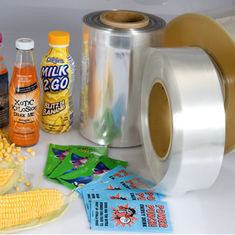Clear 50 Mic PLA Biodegradable Film For Shrink Band , Polylactic Acid Film
PLA Biodegradable Film a new, renewable and economically stable plant-based technology that replaces traditional petroleum-based shrink labels is labeling made from PolyLactic Acid (PLA). The bio-based shrink labels and tamper-evident bands made from PLA are a natural option that can reinforce the purity, natural and close to nature commitment and positioning of the natural product and nutritional supplement brands.Poly(lactic acid) or polylactic acid or polylactide (PLA) is a biodegradable and bioactive thermoplastic aliphatic polyester derived from renewable resources, such as corn starch, cassava roots, chips or starch, or sugarcane.

1. PLA Biodegradable Film Production Description
In HYF, we regularly produce PLA heat shrink films SSC100, We will make adjustment according to the customer request.
Thickness: 40/45 micro.
3” core or 6” core.
Max. OD 1000mm.
2. PLA Biodegradable Film Product key features
1) Environmental-friendly;
2) Lower oxygen omission;
3) compostable;
4) Excellent gauge and shrinkage uniformity;
5) Good ink adhesion;
6) Advanced machining properties;
7) High transparency and good gloss
3. TDS For PLA Biodegradable Film
| Item |
Unit |
Test Method |
Value |
| Thickness |
μm |
ASTM D374 |
45 |
| Tensile strength |
MD |
MPa |
ASTM D882 |
96 |
| TD |
128 |
| Elongation |
MD |
% |
ASTM D882 |
50 |
| TD |
88 |
| Heat Shrinkage |
MD |
% |
100℃/10S |
3.2 |
| TD |
78 |
| Haze |
% |
ASTM D1003 |
2.9 |
| Transmittance |
% |
|
93.3 |
| Gloss |
% |
GB/T 8807(45°) |
77 |
| C.O.F(IN/OUT) |
μS/μK |
ASTM D1894E |
0.51/0.41 |
| Wet Tension |
mN/m |
ASTM D2578 |
38 |
| Seaming Strength |
N/15mm |
|
4.61 |
4. PLA Biodegradable Film Compare with plastic shrink films
1) More environmental;
2) Slow shrinkage curve;
3) Perfect labeling
5. PLA Biodegradable Film Application
Used for sleeve labels of beverage, food can, and ect..

6. What is Biomass Plastics Film
Bioplastics are plastics derived from renewable biomass sources, such as vegetable fats and oils, corn starch, or microbiota. Bioplastic can be made from agricultural by-products and also from used plastic bottles and other containers using microorganisms. Common plastics, such as fossil-fuel plastics (also called petrobased polymers) are derived from petroleum or natural gas. Production of such plastics tends to require more fossil fuels and to produce more greenhouse gases than the production of biobased polymers (bioplastics). Not all bioplastics are biodegrade nor biodegrade more readily than commodity fossil-fuel derived plastics. Bioplastics are usually derived from sugar derivatives, including starch, cellulose, lactic acid. As of 2014, bioplastics represented approximately 0.2% of the global polymer market (300 million tons).
Biomass plastics utilize the biomass resources of regenerable biological origin. Currently, biomass plastics based on plant-derived materials are in practical use. The plastics are high-polymer materials made of raw materials consisting of starch, sugar, or cellulose contained in plants. One example is polylactic acid, the chemically-synthesized lactic acid that is fermented from starch. Even if CO2 is ejected when polylactic acid is incinerated, it is utilized in photosynthesis by growing plants that are used as materials; the CO2 in the atmosphere does not increase (carbon-neutral). Therefore, it is an environmentally-friendly material that does not contribute to global warming (Figure 1). Furthermore, this material is as strong and rigid as polystyrene. However, for polylactic acid to be used as a material in durable goods, issues related to heat resistance and impact resistance as well as flame retardancy need to be addressed; the material must provide non-flammable parts for electric and electronic devices. Furthermore, issues related to molding techniques formass production of components have to be addressed.


 Your message must be between 20-3,000 characters!
Your message must be between 20-3,000 characters! Please check your E-mail!
Please check your E-mail!  Your message must be between 20-3,000 characters!
Your message must be between 20-3,000 characters! Please check your E-mail!
Please check your E-mail! 

